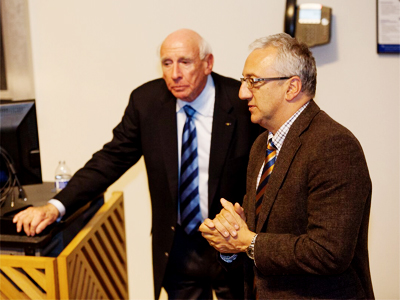Legendary Submariner Surfaces at Columbia Engineering
For Captain Alfred Scott McLaren, these career highlights are just the tip of the iceberg. Speeding across the Atlantic in the world’s fastest nuclear submarine to set a record still standing after 50 years; charting the entire Siberian continental shelf undetected, and collecting daring reconnaissance right under the enemy’s nose; and above all, shepherding his ship, crew, and country through the high-stakes global gamesmanship of the Cold War.

Captain Alfred Scott McLaren addressed an enthusiastic audience in the Northwest Corner Building as part of the School’s new Extreme Engineering speaker series.
“There are two things you need to survive on a submarine,” said McLaren, U.S. Navy (Ret.), in a talk held October 2 at Columbia Engineering. “You have to have a sense of humor, and the ability to create a sense of space by living in your own head.”
McLaren addressed an enthusiastic audience in the Northwest Corner Building as part of the School’s new Extreme Engineering speaker series co-sponsored by the Department of Mechanical Engineering. Former NASA astronaut and Professor of Professional Practice Mike Massimino introduced McLaren as “one of the most extraordinary men I’ve ever met.”
In addition to serving aboard five nuclear submarines and earning his own command, McLaren is an accomplished explorer and scientist who has published more than 50 peer-reviewed research papers and logged some five and a half years underwater. He reflected on his extraordinary career, from still-classified naval operations he could only broadly outline—“or else I’d have to kill you,” he deadpanned—to expeditions investigating sea ice, traversing the Northwest Passage, and exploring the wrecks of the Titanic and Bismarck.
“We really were one with those submarines,” McLaren said, describing daily life aboard vessels so crowded that unlucky crewmen slept on torpedoes, but where cockroaches picked up across the Pacific often vastly outnumbered the men who would catch and race them on clipboards. He noted that food is 98% of morale. “We had an unlimited food allowance—we ate like kings!”

Former NASA astronaut and Professor of Professional Practice Mike Massimino introduced McLaren at the October 2 event.
He shared countless memories from his years at sea, from a pick-up baseball game across time zones at the North Pole (the ball is at the Baseball Hall of Fame), to surfacing next to polar bears who seemed to think his submarine was a seal, to the hissing of melting icebergs audible 70 miles out. He talked about the dangers of icebergs both above and below the surface, where vessels can easily get caught in tight hollows he called “ice garages.”
“The sound of ice going down a steel hull is like a million scratches on a blackboard,” he said.
McLaren also discussed advances in submarine technology from unwieldy behemoths to agile craft controlled more like airplanes, and his relationship with Admiral Hyman G. Rickover MS’29, widely known as the “father of the nuclear navy.” He credited Rickover’s famously stringent safety standards for protecting American personnel from radiation poisoning.
“Life is a rich smorgasbord, live every moment to the fullest,” he concluded.
McLaren is president of the American Polar Society, president emeritus of the Explorers Club, and senior pilot of the Super Aviator submersible. He is also the author of several books, including his latest, Silent and Unseen: On Patrol in Three Cold War Attack Submarines.
The next installment of the Extreme Engineering series will welcome astronaut and ace pilot Captain Scott “Scooter” Altman on November 19. The special series kicked off on Sept. 27 with a panel discussion featuring NASA and Mars experts centered on the current film, The Martian, starring Matt Damon and directed by Ridley Scott.
